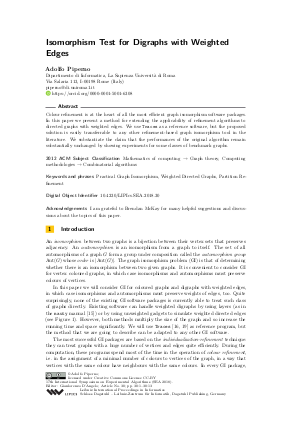Isomorphism Test for Digraphs with Weighted Edges
Author
Adolfo Piperno 
-
Part of:
Volume:
17th International Symposium on Experimental Algorithms (SEA 2018)
Part of: Series: Leibniz International Proceedings in Informatics (LIPIcs)
Part of: Conference: International Symposium on Experimental Algorithms (SEA) - License:
 Creative Commons Attribution 3.0 Unported license
Creative Commons Attribution 3.0 Unported license
- Publication Date: 2018-06-19
File

PDF
LIPIcs.SEA.2018.30.pdf
- Filesize: 1.39 MB
- 13 pages
Document Identifiers
Subject Classification
ACM Subject Classification
- Mathematics of computing → Graph theory
- Computing methodologies → Combinatorial algorithms
Keywords
- Practical Graph Isomorphism
- Weighted Directed Graphs
- Partition Refinement
Metrics
- Access Statistics
-
Total Accesses (updated on a weekly basis)
0Document
0Metadata
Abstract
Colour refinement is at the heart of all the most efficient graph isomorphism software packages. In this paper we present a method for extending the applicability of refinement algorithms to directed graphs with weighted edges. We use {Traces} as a reference software, but the proposed solution is easily transferrable to any other refinement-based graph isomorphism tool in the literature. We substantiate the claim that the performances of the original algorithm remain substantially unchanged by showing experiments for some classes of benchmark graphs.
Cite As Get BibTex
Adolfo Piperno. Isomorphism Test for Digraphs with Weighted Edges. In 17th International Symposium on Experimental Algorithms (SEA 2018). Leibniz International Proceedings in Informatics (LIPIcs), Volume 103, pp. 30:1-30:13, Schloss Dagstuhl – Leibniz-Zentrum für Informatik (2018)
https://doi.org/10.4230/LIPIcs.SEA.2018.30
BibTex
@InProceedings{piperno:LIPIcs.SEA.2018.30,
author = {Piperno, Adolfo},
title = {{Isomorphism Test for Digraphs with Weighted Edges}},
booktitle = {17th International Symposium on Experimental Algorithms (SEA 2018)},
pages = {30:1--30:13},
series = {Leibniz International Proceedings in Informatics (LIPIcs)},
ISBN = {978-3-95977-070-5},
ISSN = {1868-8969},
year = {2018},
volume = {103},
editor = {D'Angelo, Gianlorenzo},
publisher = {Schloss Dagstuhl -- Leibniz-Zentrum f{\"u}r Informatik},
address = {Dagstuhl, Germany},
URL = {https://drops.dagstuhl.de/entities/document/10.4230/LIPIcs.SEA.2018.30},
URN = {urn:nbn:de:0030-drops-89659},
doi = {10.4230/LIPIcs.SEA.2018.30},
annote = {Keywords: Practical Graph Isomorphism, Weighted Directed Graphs, Partition Refinement}
}
Author Details
References
-
V.L. Arlazarov, I.I. Zuev, A.V. Uskov, and I.A. Faradzhev. An algorithm for the reduction of finite non-oriented graphs to canonical form. USSR Computational Mathematics and Mathematical Physics, 14(3):195-201, 1974.

-
László Babai. Graph isomorphism in quasipolynomial time [extended abstract]. In Proceedings of the Forty-eighth Annual ACM Symposium on Theory of Computing, STOC '16, pages 684-697, New York, NY, USA, 2016. ACM.

-
Christoph Berkholz, Paul Bonsma, and Martin Grohe. Tight lower and upper bounds for the complexity of canonical colour refinement. In Hans L. Bodlaender and Giuseppe F. Italiano, editors, Algorithms - ESA 2013, pages 145-156. Springer Berlin Heidelberg, 2013.

-
Jin-Yi Cai, Martin Fürer, and Neil Immerman. An optimal lower bound on the number of variables for graph identification. Combinatorica, 12(4):389-410, 1992.

-
D. G. Corneil and C. C. Gotlieb. An efficient algorithm for graph isomorphism. J. ACM, 17(1):51-64, 1970.

-
Paul T. Darga, Mark H. Liffiton, Karem A. Sakallah, and Igor L. Markov. Exploiting structure in symmetry detection for cnf. In Proceedings of the 41st Annual Design Automation Conference, DAC '04, pages 530-534, New York, NY, USA, 2004. ACM.

-
Paul T. Darga, Karem A. Sakallah, and Igor L. Markov. Faster symmetry discovery using sparsity of symmetries. In Proceedings of the 45th Annual Design Automation Conference, DAC '08, pages 149-154, New York, NY, USA, 2008. ACM.

-
John Hopcroft. An n log n algorithm for minimizing states in a finite automaton. In Zvi Kohavi and Azaria Paz, editors, Theory of Machines and Computations, pages 189-196. Academic Press, 1971.

-
Tommi Junttila and Petteri Kaski. Engineering an efficient canonical labeling tool for large and sparse graphs. In Proceedings of the Meeting on Algorithm Engineering &Expermiments, pages 135-149, Philadelphia, PA, USA, 2007. Society for Industrial and Applied Mathematics.

-
Tommi Junttila and Petteri Kaski. Conflict propagation and component recursion for canonical labeling. In Alberto Marchetti-Spaccamela and Michael Segal, editors, Theory and Practice of Algorithms in (Computer) Systems, pages 151-162. Springer Berlin Heidelberg, 2011.

- José Luis López-Presa, Antonio Fernández Anta, and Luis Núñez Chiroque. Conauto-2.0: Fast isomorphism testing and automorphism group computation. CoRR, abs/1108.1060, 2011. URL: http://arxiv.org/abs/1108.1060.
-
José Luis López-Presa and Antonio Fernández Anta. Fast algorithm for graph isomorphism testing. In Jan Vahrenhold, editor, Experimental Algorithms, pages 221-232. Springer Berlin Heidelberg, 2009.

-
Brendan D. McKay. Practical graph isomorphism. Congressus Numerantium, 30:45-87, 1980.

- Brendan D. McKay and Adolfo Piperno. nauty and Traces, software distribution web pages. http://cs.anu.edu.au/~bdm/nauty and URL: http://pallini.di.uniroma1.it.
- Brendan D. McKay and Adolfo Piperno. nauty and Traces user’s guide (version 2.6). Available at http://cs.anu.edu.au/~bdm/nauty and URL: http://pallini.di.uniroma1.it.
-
Brendan D. McKay and Adolfo Piperno. Practical graph isomorphism, ii. Journal of Symbolic Computation, 60:94-112, 2014.

-
Daniel Neuen and Pascal Schweitzer. Benchmark graphs for practical graph isomorphism. In 25th Annual European Symposium on Algorithms, ESA 2017, September 4-6, 2017, Vienna, Austria, pages 60:1-60:14, 2017.

-
R. Parris and Ronald C. Read. A coding procedure for graphs. Technical report, Univ. of West Indies Computer Centre, 1969.

- Adolfo Piperno. Search space contraction in canonical labeling of graphs (preliminary version). CoRR, abs/0804.4881, 2008. URL: http://arxiv.org/abs/0804.4881.
